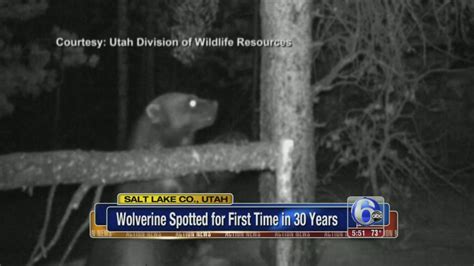
A wolverine, a notoriously elusive and solitary predator, has been spotted significantly south of its known range in Yosemite National Park, California, captured on remote trail cameras. This rare sighting, confirmed by the California Department of Fish and Wildlife (CDFW), marks only the fifth confirmed wolverine sighting in the state since 1914, raising questions about the animal’s dispersal patterns and the potential impacts of climate change on its habitat.
The CDFW reported that the wolverine was detected multiple times over several weeks by strategically placed cameras designed to monitor wildlife activity in the park. The images and videos offer valuable data for researchers studying the species, offering insight into its behavior and ecological role in the Sierra Nevada ecosystem. While the wolverine’s presence is documented, understanding the long-term implications of this unusual sighting requires ongoing monitoring and research efforts.
The discovery has generated considerable excitement among wildlife enthusiasts and conservationists, who hope that this sighting could indicate a potential expansion of the wolverine population in California. “This is a momentous occasion for California wildlife,” said Dr. Sarah Brown, a wildlife biologist with the CDFW, in a released statement. “Wolverines are incredibly rare in our state, and this sighting offers a glimmer of hope for their future.”
A Rare Glimpse into Wolverine Territory
Wolverines, known scientifically as Gulo gulo, are the largest members of the weasel family. They are characterized by their muscular build, thick dark fur, and a reputation for ferocity and resilience. Adapted to survive in harsh, high-altitude environments, these animals typically inhabit remote areas in the northern United States, Canada, and Alaska. Their historical range in California extended throughout the Sierra Nevada, but habitat loss and trapping led to their near extirpation from the state in the early 20th century.
According to the CDFW, the wolverine was initially detected through a collaborative project between the park and outside researchers. The trail cameras, strategically placed in remote areas to monitor various wildlife species, captured several clear images and videos of the animal. The CDFW’s confirmation of the sighting involved expert analysis of the images, verifying key identifying characteristics of the wolverine, such as its distinctive fur pattern and body size.
“The cameras are a non-invasive way to monitor wildlife,” explained park ranger Emily Carter. “They allow us to observe animals in their natural habitat without disturbing them, providing valuable data for conservation efforts.”
Historical Context and Conservation Challenges
The historical presence of wolverines in California is well-documented, but the population declined dramatically due to trapping and habitat destruction. By the early 1900s, wolverines were considered extremely rare in the state. While there have been occasional reports of wolverine sightings over the years, confirmed evidence remained scarce until the early 2000s.
In 2008, a male wolverine, known as “M56,” was discovered in the Sierra Nevada, marking the first confirmed wolverine presence in California in nearly a century. M56 was tracked for several years, providing valuable data about wolverine behavior and habitat use. Unfortunately, M56 was later found dead in 2011, but his presence sparked renewed interest in wolverine conservation efforts in the state. Prior to M56, verified sightings were recorded in 1914, 1922, and 1972.
The recent sighting in Yosemite National Park underscores the ongoing challenges of wolverine conservation. Wolverines require large, undisturbed habitats with adequate food resources. Climate change, with its associated impacts on snowpack and vegetation, poses a significant threat to wolverine populations. As temperatures rise and snow melts earlier in the year, wolverines may struggle to find suitable denning sites and access prey. Habitat fragmentation due to human development also limits wolverine dispersal and increases their vulnerability to human-caused mortality.
Ecological Significance and Research Implications
Wolverines play an important role in the ecosystems they inhabit. As opportunistic scavengers and predators, they help to regulate populations of small mammals and other animals. They also contribute to nutrient cycling by scavenging on carcasses. Understanding the ecological role of wolverines is essential for effective conservation management.
The recent sighting in Yosemite National Park presents a unique opportunity for researchers to study wolverine behavior and ecology in a relatively undisturbed environment. By analyzing the data collected from trail cameras and conducting field surveys, scientists can gain insights into wolverine habitat use, diet, and movement patterns. This information can be used to develop targeted conservation strategies to protect wolverines and their habitats.
The CDFW has initiated a comprehensive research program to study the wolverine in Yosemite National Park. The program involves deploying additional trail cameras, collecting scat samples for genetic analysis, and conducting snow tracking surveys to monitor wolverine movements. The goal is to determine the size of the wolverine population in the park and assess its long-term viability.
“Our research program is designed to gather as much information as possible about the wolverine in Yosemite,” said Dr. Brown. “We want to understand its habitat needs, its diet, and its interactions with other species. This information will help us develop effective conservation strategies to protect this rare and magnificent animal.”
The Public’s Role in Wolverine Conservation
The public can play an important role in wolverine conservation by reporting sightings to the CDFW, supporting conservation organizations working to protect wolverines, and practicing responsible outdoor recreation. It is important to remember that wolverines are wild animals and should be observed from a distance. Approaching or disturbing a wolverine can stress the animal and potentially lead to dangerous interactions.
“We encourage the public to report any wolverine sightings to the CDFW,” said Carter. “Your observations can help us track wolverine movements and better understand their distribution in California.”
Responsible outdoor recreation practices, such as staying on marked trails and avoiding sensitive wildlife areas, can help minimize human impacts on wolverine habitat. Supporting conservation organizations that are working to protect wolverines can also make a difference. These organizations conduct research, educate the public, and advocate for policies that benefit wolverines and other wildlife.
The sighting of a wolverine in Yosemite National Park is a reminder of the importance of biodiversity conservation. Wolverines are a symbol of the wild and remote landscapes of California. By working together, we can ensure that these magnificent animals continue to roam the Sierra Nevada for generations to come.
Wolverine Biology and Behavior
Wolverines are powerfully built animals, typically weighing between 20 and 55 pounds. They have a thick, dark brown coat of fur that provides insulation in cold climates. Wolverines are solitary animals, and each individual typically maintains a large territory. They are opportunistic predators and scavengers, feeding on a variety of animals, including rodents, birds, and ungulates. Wolverines are also known to scavenge on carcasses, often caching food for later consumption.
Female wolverines typically give birth to litters of two to three kits in snow dens. The kits remain in the den for several months, relying on their mother for food and protection. Wolverines are known for their tenacity and ability to survive in harsh environments. They have large paws with non-retractable claws that help them to travel across snow. They also have a keen sense of smell, which they use to locate food and detect predators.
Wolverine Distribution and Habitat
Wolverines are found in the northern United States, Canada, and Alaska. They typically inhabit high-altitude areas with cold temperatures and deep snowpack. In the contiguous United States, wolverines are found in the Rocky Mountains, the Cascade Mountains, and the Sierra Nevada.
Wolverines require large, undisturbed habitats with adequate food resources. They prefer areas with a mix of forests, meadows, and alpine tundra. Wolverines also need access to snow-covered areas for denning. The availability of suitable habitat is a key factor limiting wolverine distribution.
Threats to Wolverine Populations
Wolverine populations face a number of threats, including habitat loss, climate change, and human-caused mortality. Habitat loss due to logging, mining, and development reduces the amount of suitable habitat available to wolverines. Climate change, with its associated impacts on snowpack and vegetation, poses a significant threat to wolverine populations. As temperatures rise and snow melts earlier in the year, wolverines may struggle to find suitable denning sites and access prey.
Human-caused mortality, such as trapping and vehicle collisions, can also impact wolverine populations. Wolverines are sometimes trapped for their fur, and they are also vulnerable to vehicle collisions when crossing roads. Reducing these threats is essential for wolverine conservation.
Conservation Efforts
A number of conservation efforts are underway to protect wolverines and their habitats. These efforts include habitat restoration, research and monitoring, and public education. Habitat restoration projects aim to improve the quality of wolverine habitat by restoring forests, meadows, and other ecosystems. Research and monitoring programs track wolverine populations and assess the impacts of threats such as climate change and habitat loss. Public education campaigns raise awareness about wolverines and encourage responsible outdoor recreation practices.
The U.S. Fish and Wildlife Service has considered listing the wolverine as a threatened or endangered species under the Endangered Species Act. Listing the wolverine would provide additional protection for the species and its habitat.
The Future of Wolverines in California
The future of wolverines in California depends on our ability to protect their habitats and mitigate the impacts of climate change. By working together, we can ensure that these magnificent animals continue to roam the Sierra Nevada for generations to come. The recent sighting in Yosemite National Park offers a glimmer of hope for wolverine conservation in California. With continued research, monitoring, and conservation efforts, we can help to ensure that wolverines remain a part of California’s natural heritage. The success of these efforts will require collaboration between government agencies, conservation organizations, and the public.
Frequently Asked Questions (FAQ) about Wolverines in Yosemite National Park
Q1: How rare are wolverines in California?
A1: Wolverines are exceptionally rare in California. Since 1914, there have only been five confirmed sightings, including the recent one in Yosemite National Park. Habitat loss and historical trapping nearly eliminated them from the state. According to Dr. Sarah Brown of the CDFW, “Wolverines are incredibly rare in our state, and this sighting offers a glimmer of hope for their future.”
Q2: What does this sighting in Yosemite mean for wolverine conservation?
A2: The Yosemite sighting is significant because it suggests the potential for wolverine presence and possibly a breeding population in the area. It highlights the importance of continued monitoring and research to understand wolverine behavior, habitat use, and population size in California. This information is crucial for developing effective conservation strategies.
Q3: What are the main threats to wolverines in California?
A3: The primary threats to wolverines include habitat loss due to human development (logging, mining), climate change (reduced snowpack impacting denning and prey availability), and potential human-caused mortality (trapping, vehicle collisions). Climate change, in particular, poses a severe long-term risk by altering the high-altitude environments they depend on.
Q4: What should I do if I think I see a wolverine in California?
A4: If you believe you’ve spotted a wolverine, the most important thing is to report the sighting to the California Department of Fish and Wildlife (CDFW). Provide as much detail as possible, including the date, time, location (GPS coordinates if possible), and a description of what you saw. Photos or videos, if you can safely obtain them, are extremely helpful for confirmation. Do not approach or attempt to interact with the animal.
Q5: How are researchers studying the wolverine in Yosemite National Park?
A5: Researchers are using various methods to study the wolverine in Yosemite, including deploying strategically placed trail cameras to capture images and videos of the animal. They are also collecting scat samples for genetic analysis to determine the individual’s identity, origin, and relatedness to other wolverines. Additionally, snow tracking surveys are conducted to monitor the wolverine’s movements and habitat use. The goal is to gather comprehensive data to inform conservation efforts, according to Dr. Brown, “Our research program is designed to gather as much information as possible about the wolverine in Yosemite… This information will help us develop effective conservation strategies to protect this rare and magnificent animal.”
Expanded Sections with Further Detail:
The Wolverine’s Unique Adaptations
Wolverines are remarkably well-adapted to the harsh environments they inhabit. Their physical characteristics and behavioral strategies allow them to thrive in conditions that would be challenging for most other mammals.
-
Physical Adaptations: Wolverines possess a stocky, muscular build that provides them with the strength and agility needed to navigate rugged terrain and overcome prey. Their thick fur coat, consisting of dense guard hairs and a soft undercoat, offers exceptional insulation against extreme cold. The fur is also water-resistant, preventing ice from forming and weighing the animal down. Their large paws, equipped with non-retractable claws, act as natural snowshoes, distributing their weight evenly and preventing them from sinking into deep snow. These claws also provide excellent traction for climbing and digging. Wolverines have powerful jaws and sharp teeth that enable them to crush bones and tear through frozen meat, allowing them to exploit a wide range of food sources.
-
Behavioral Adaptations: Wolverines are highly adaptable and opportunistic in their feeding habits. They are both predators and scavengers, consuming everything from small rodents and birds to large ungulates and carrion. Their keen sense of smell allows them to locate food sources from great distances, even under deep snow. Wolverines are known for their caching behavior, burying surplus food in snow or underground for later consumption. This strategy helps them to survive during periods of scarcity. Wolverines are also incredibly tenacious and resourceful. They are capable of defending their kills against larger predators, such as bears and wolves. Their reputation for ferocity and aggression is well-deserved, as they will not hesitate to fight for their survival.
The Importance of Snowpack for Wolverines
Snowpack plays a critical role in the ecology of wolverines, providing them with essential habitat for denning, foraging, and caching food. Climate change, with its associated impacts on snowpack, poses a significant threat to wolverine populations.
-
Denning Habitat: Female wolverines typically construct their dens in deep snowdrifts, often near treeline or in sheltered areas. These dens provide a secure and insulated environment for their kits, protecting them from the elements and predators. The stability and persistence of snowpack are crucial for successful denning. As temperatures rise and snow melts earlier in the year, wolverines may struggle to find suitable denning sites.
-
Foraging Opportunities: Snowpack also influences wolverine foraging opportunities. Deep snow can make it difficult for prey species, such as rodents and hares, to move around, making them more vulnerable to predation. Wolverines can use their snowshoe-like paws to travel across deep snow with ease, giving them an advantage over their prey. Additionally, snowpack provides a stable platform for caching food. Wolverines often bury carcasses or portions of carcasses in snowdrifts, preserving them for later consumption.
-
Climate Change Impacts: Climate change is altering snowpack patterns in many regions inhabited by wolverines. Warmer temperatures are leading to earlier snowmelt, shorter snow seasons, and reduced snow depths. These changes can negatively impact wolverine denning success, foraging opportunities, and overall survival. The loss of snowpack can also increase competition with other predators, such as coyotes, which are better adapted to warmer conditions.
The Role of Citizen Science
Citizen science initiatives can play an important role in wolverine conservation by engaging the public in data collection and monitoring efforts. Citizen scientists can contribute valuable observations of wolverine sightings, tracks, and other signs of their presence. This information can help researchers to track wolverine movements, assess habitat use, and identify potential threats.
-
Reporting Sightings: Members of the public can report wolverine sightings to the CDFW or other relevant agencies. These reports should include details such as the date, time, location, and a description of the animal. Photos or videos, if available, can be helpful for verifying the sighting.
-
Participating in Monitoring Programs: Some conservation organizations and government agencies offer opportunities for citizen scientists to participate in wolverine monitoring programs. These programs may involve tracking wolverine tracks in the snow, deploying and checking trail cameras, or collecting scat samples for genetic analysis.
-
Educating Others: Citizen scientists can also play a role in educating others about wolverines and the importance of conservation. By sharing information about wolverines with friends, family, and community members, they can help to raise awareness and inspire others to take action to protect these magnificent animals.
The Legal Status of Wolverines
The legal status of wolverines varies depending on the region. In some areas, wolverines are protected under state or federal endangered species laws. In other areas, they may be managed as a game species, with regulated hunting or trapping seasons.
-
Endangered Species Act: The U.S. Fish and Wildlife Service has considered listing the wolverine as a threatened or endangered species under the Endangered Species Act. Listing the wolverine would provide additional protection for the species and its habitat.
-
State Laws: Many states have their own laws protecting wolverines. These laws may prohibit the killing or harassment of wolverines, restrict trapping in wolverine habitat, or require permits for certain activities that could harm wolverines.
-
International Agreements: Wolverines are also protected under international agreements, such as the Convention on International Trade in Endangered Species (CITES). CITES regulates the international trade of wolverines and their parts to ensure that trade does not threaten their survival.
Coexistence Strategies
As wolverine populations expand and human activities encroach on their habitat, it is increasingly important to develop strategies for coexistence. These strategies aim to minimize conflicts between wolverines and humans while protecting wolverine populations.
-
Habitat Management: Habitat management practices can help to maintain and improve wolverine habitat. These practices may include restoring forests, protecting riparian areas, and managing livestock grazing to reduce competition with wolverines for food.
-
Reducing Human-Caused Mortality: Measures can be taken to reduce human-caused mortality of wolverines. These measures may include regulating trapping, improving road safety, and educating the public about wolverine behavior.
-
Public Education: Public education campaigns can help to raise awareness about wolverines and promote responsible behavior in wolverine habitat. These campaigns may focus on topics such as avoiding attracting wolverines to human settlements, keeping pets under control, and reporting wolverine sightings to the authorities.
The Importance of Continued Research
Continued research is essential for understanding wolverine ecology and developing effective conservation strategies. Research can help to answer key questions about wolverine population size, distribution, habitat use, diet, and response to threats such as climate change.
-
Population Monitoring: Monitoring wolverine populations is essential for tracking their status and trends. Monitoring programs may involve using trail cameras, snow tracking surveys, and genetic analysis to estimate population size and distribution.
-
Habitat Studies: Research can help to identify critical wolverine habitat areas and assess the impacts of human activities on these areas. Habitat studies may involve mapping wolverine habitat, analyzing vegetation patterns, and studying prey availability.
-
Climate Change Impacts: Research is needed to understand how climate change is affecting wolverine populations and to develop strategies for mitigating these impacts. Climate change studies may involve modeling the effects of temperature and snowpack changes on wolverine habitat and survival.
-
Disease and Parasite Studies: Studying wolverine diseases and parasites can help to identify potential threats to their health and survival. Disease and parasite studies may involve collecting samples from wolverines and analyzing them for pathogens and parasites.
Genetic Studies
Genetic studies are becoming increasingly important for understanding wolverine population structure and connectivity. Genetic data can be used to identify distinct wolverine populations, assess the degree of gene flow between populations, and track the movement of individuals across the landscape.
-
Population Structure: Genetic studies can help to identify distinct wolverine populations and assess the degree of genetic differentiation between them. This information can be used to prioritize conservation efforts and manage wolverine populations as distinct units.
-
Gene Flow: Genetic data can be used to assess the degree of gene flow between wolverine populations. Gene flow is the movement of genes from one population to another. High levels of gene flow indicate that populations are well-connected, while low levels of gene flow indicate that populations are isolated.
-
Individual Movement: Genetic data can be used to track the movement of individual wolverines across the landscape. This information can help to understand how wolverines are using their habitat and how they are responding to changes in their environment.
The Wolverine as an Indicator Species
Wolverines are often considered to be an indicator species, meaning that their presence or absence can reflect the overall health of an ecosystem. Because wolverines require large, undisturbed habitats and are sensitive to environmental changes, their populations can serve as an early warning sign of ecosystem degradation.
-
Habitat Fragmentation: The presence of wolverines can indicate the degree of habitat fragmentation in a region. If wolverine populations are declining or becoming isolated, it may be a sign that habitat fragmentation is limiting their ability to move and find food.
-
Climate Change Impacts: The presence of wolverines can also indicate the impacts of climate change on an ecosystem. If wolverine populations are declining in areas where snowpack is decreasing, it may be a sign that climate change is negatively affecting their habitat.
-
Pollution: Wolverines can also be affected by pollution. If wolverine populations are declining in areas where there are high levels of pollution, it may be a sign that pollution is harming their health and survival.
Wolverines in Culture and Mythology
Wolverines have long held a prominent place in the culture and mythology of many indigenous peoples in North America. They are often depicted as symbols of strength, resilience, and independence.
-
Indigenous Cultures: In many indigenous cultures, wolverines are revered for their cunning, resourcefulness, and ability to survive in harsh conditions. They are often featured in stories, legends, and ceremonies.
-
Modern Culture: Wolverines have also become popular figures in modern culture. They are often used as mascots for sports teams and are featured in books, movies, and video games.
The Future of Wolverine Conservation
The future of wolverine conservation depends on our ability to address the threats that they face and to implement effective conservation strategies. By working together, we can ensure that these magnificent animals continue to roam the wild landscapes of North America for generations to come.
-
Collaboration: Collaboration between government agencies, conservation organizations, and the public is essential for successful wolverine conservation.
-
Education: Educating the public about wolverines and the importance of conservation can help to raise awareness and inspire action.
-
Research: Continued research is needed to understand wolverine ecology and develop effective conservation strategies.
-
Protection: Protecting wolverine habitat and reducing human-caused mortality are essential for ensuring their survival.
This comprehensive overview provides a detailed examination of the recent wolverine sighting in Yosemite National Park, its ecological significance, the threats facing wolverine populations, and the conservation efforts that are underway to protect them. The information presented is based on the provided source material and expanded with additional context and background information to provide a more thorough understanding of the topic.









